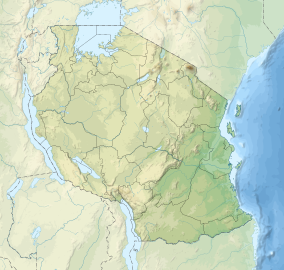Mikumi National Park
This article needs additional citations for verification. (April 2016) |
| Mikumi National Park | |
|---|---|
 Mikumi National Park scene | |
 | |
| Location | Mikumi near Morogoro, Tanzania |
| Nearest city | Dar es Salaam |
| Coordinates | 7°12′S 37°08′E / 7.200°S 37.133°ECoordinates: 7°12′S 37°08′E / 7.200°S 37.133°E |
| Area | 3,230 km² |
| Established | 1964 |
| Visitors | 41,666 (in 2012[1]) |
| Governing body | Tanzania National Parks Authority (TANAPA) |
| Website | www |
The Mikumi National Park near Morogoro, Tanzania, was established in 1964. It covers an area of 3,230 km2 is the fourth largest in the country.[2] The park is crossed by Tanzania's A-7 highway.
Territory[]
Mikumi National Park borders Selous Game Reserve on the south, the two areas forming a unique ecosystem.[2] Two other natural areas bordering the national park are the Udzungwa Mountains and Uluguru Mountains. Malundwe Mountain is within the park, the highest of a belt of hills that run east and west through the park, connecting the Uluguru Mountains to the northeast with the Uvidunda and Udzungwa mountains to the west. Malundwe Mountain consists of three peaks along a ridge running north and south. Malundwe's south peak is the highest point in the park, reaching 1290 meters elevation.[3]
Flora and fauna[]

The landscape of Mikumi is often compared to that of the Serengeti. The road that crosses the park divides it into two areas with partially distinct environments. The area north-west is characterized by the alluvial plain of the river basin Mkata. The vegetation of this area consists of savannah dotted with acacia, baobab, tamarinds, and some rare palm. In this area, at the furthest from the road, there are spectacular rock formations of the mountains Rubeho and Uluguru. The southeast part of the park is less rich in wildlife, and not very accessible.
The fauna includes many species characteristic of the African savannah. According to local guides at Mikumi, chances of seeing a lion who climbs a tree trunk is larger than in Manyara (famous for being one of the few places where the lions exhibit this behavior). The park contains a subspecies of giraffe that biologists consider the link between the Masai giraffe and the reticulated or Somali giraffe. Other animals in the park are elephants, zebras, impala, eland, kudu, black antelope, baboons, wildebeests and buffaloes. At about 5 km from the north of the park, there are two artificial pools inhabited by hippos. More than 400 different species of birds also inhabit the park.[2]
Tourism[]
The Mikumi belongs to the circuit of the wildlife parks of Tanzania, less visited by international tourists and better protected from the environmental point of view. Most of the routes that cross the Mikumi proceed in the direction of the Ruaha National Park and the Selous. The recommended season for visiting the park is the dry season between May and November, warm weather and beautiful sites that are a once-in-a-lifetime experience.
Gallery[]
Mikumi park entrance

Mikumi landscape

Mikumi landscape

A lioness in Mikumi National Park

A blue wildebeest trotting
A buffalo
References[]
- ^ "Tanzania National parks Corporate Information". Tanzania Parks. TANAPA. Archived from the original on 20 December 2015. Retrieved 22 December 2015.
- ^ Jump up to: a b c "Mikumi National Park". Tanzania Tourism. Archived from the original on 7 May 2017. Retrieved 15 May 2017.
- ^ Collett, Leah; Hawkins, Dawn; ho, Charles; Marwa, William; Norton, Guy (December 2007). A description and evaluation of Malundwe Mountain forest in Mikumi National Park, Tanzania. 6th Tanzania Wildlife Research Institute (TAWIRI) Scientific Conference. Arusha, Tanzania. Retrieved 8 October 2019.
External links[]
| Wikimedia Commons has media related to Mikumi National Park. |
- IUCN Category II
- Eastern miombo woodlands
- National parks of Tanzania
- Protected areas established in 1964
- 1964 establishments in Tanzania
- Geography of Morogoro Region
- Tourist attractions in the Morogoro Region









